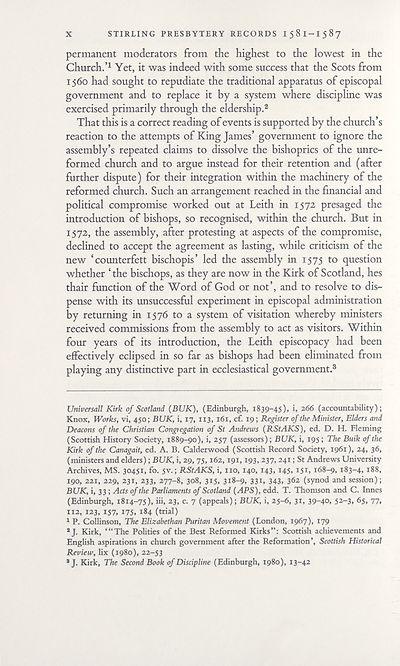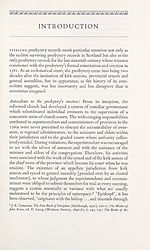Series 4 > Stirling Presbytery Records 1581-1587
(15) Page x
Download files
Complete book:
Individual page:
Thumbnail gallery: Grid view | List view

X STIRLING PRESBYTERY RECORDS I581-I587
permanent moderators from the highest to the lowest in the
Church.’1 Yet, it was indeed with some success that the Scots from
1560 had sought to repudiate the traditional apparatus of episcopal
government and to replace it by a system where discipline was
exercised primarily through the eldership.2
That this is a correct reading of events is supported by the church’s
reaction to the attempts of King James’ government to ignore the
assembly’s repeated claims to dissolve the bishoprics of the unre¬
formed church and to argue instead for their retention and (after
further dispute) for their integration within the machinery of the
reformed church. Such an arrangement reached in the financial and
political compromise worked out at Leith in 1572 presaged the
introduction of bishops, so recognised, within the church. But in
1572, the assembly, after protesting at aspects of the compromise,
declined to accept the agreement as lasting, while criticism of the
new ‘counterfeit bischopis’ led the assembly in 1575 to question
whether ‘ the bischops, as they are now in the Kirk of Scotland, hes
thair function of the Word of God or not’, and to resolve to dis¬
pense with its unsuccessful experiment in episcopal administration
by returning in 1576 to a system of visitation whereby ministers
received commissions from the assembly to act as visitors. Within
four years of its introduction, the Leith episcopacy had been
effectively eclipsed in so far as bishops had been eliminated from
playing any distinctive part in ecclesiastical government.3
Universall Kirk of Scotland (BUK), (Edinburgh, 1839-45), i. 266 (accountability);
Knox, Works, vi, 450; BUK, i, 17, 113, 161, cf. 19; Register of the Minister, Elders and
Deacons of the Christian Congregation of St Andrews (RStAKS), ed. D. H. Fleming
(Scottish History Society, 1889-90), i, 257 (assessors); BUK, i, 195; The Buik of the
Kirk of the Canagait, ed. A. B. Calderwood (Scottish Record Society, 1961), 24, 36,
(ministers and elders); BUK, i, 29, 75,162,191,193,237, 241; St Andrews University
Archives, MS. 30451, fo. 5v.; RStAKS, i, no, 140, 143, 145, 151, 168-9, 183-4. 188,
190, 221, 229, 231, 233, 277-8, 308, 315, 318-9, 331. 343, 362 (synod and session);
BUK, i, 33 ; Acts of the Parliaments of Scotland (APS), edd. T. Thomson and C. Innes
(Edinburgh, 1814-75), iii, 23, c. 7 (appeals); BUK, i, 25-6, 31, 39-40, 52-3, 65, 77,
112, 123, 157, 175, 184 (trial)
1 P. Collinson, The Elizabethan Puritan Movement (London, 1967), 179
2 J. Kirk, ‘“The Polities of the Best Reformed Kirks”: Scottish achievements and
English aspirations in church government after the Reformation’, Scottish Historical
Review, lix (1980), 22-53
2 J. Kirk, The Second Book of Discipline (Edinburgh, 1980), 13-42
permanent moderators from the highest to the lowest in the
Church.’1 Yet, it was indeed with some success that the Scots from
1560 had sought to repudiate the traditional apparatus of episcopal
government and to replace it by a system where discipline was
exercised primarily through the eldership.2
That this is a correct reading of events is supported by the church’s
reaction to the attempts of King James’ government to ignore the
assembly’s repeated claims to dissolve the bishoprics of the unre¬
formed church and to argue instead for their retention and (after
further dispute) for their integration within the machinery of the
reformed church. Such an arrangement reached in the financial and
political compromise worked out at Leith in 1572 presaged the
introduction of bishops, so recognised, within the church. But in
1572, the assembly, after protesting at aspects of the compromise,
declined to accept the agreement as lasting, while criticism of the
new ‘counterfeit bischopis’ led the assembly in 1575 to question
whether ‘ the bischops, as they are now in the Kirk of Scotland, hes
thair function of the Word of God or not’, and to resolve to dis¬
pense with its unsuccessful experiment in episcopal administration
by returning in 1576 to a system of visitation whereby ministers
received commissions from the assembly to act as visitors. Within
four years of its introduction, the Leith episcopacy had been
effectively eclipsed in so far as bishops had been eliminated from
playing any distinctive part in ecclesiastical government.3
Universall Kirk of Scotland (BUK), (Edinburgh, 1839-45), i. 266 (accountability);
Knox, Works, vi, 450; BUK, i, 17, 113, 161, cf. 19; Register of the Minister, Elders and
Deacons of the Christian Congregation of St Andrews (RStAKS), ed. D. H. Fleming
(Scottish History Society, 1889-90), i, 257 (assessors); BUK, i, 195; The Buik of the
Kirk of the Canagait, ed. A. B. Calderwood (Scottish Record Society, 1961), 24, 36,
(ministers and elders); BUK, i, 29, 75,162,191,193,237, 241; St Andrews University
Archives, MS. 30451, fo. 5v.; RStAKS, i, no, 140, 143, 145, 151, 168-9, 183-4. 188,
190, 221, 229, 231, 233, 277-8, 308, 315, 318-9, 331. 343, 362 (synod and session);
BUK, i, 33 ; Acts of the Parliaments of Scotland (APS), edd. T. Thomson and C. Innes
(Edinburgh, 1814-75), iii, 23, c. 7 (appeals); BUK, i, 25-6, 31, 39-40, 52-3, 65, 77,
112, 123, 157, 175, 184 (trial)
1 P. Collinson, The Elizabethan Puritan Movement (London, 1967), 179
2 J. Kirk, ‘“The Polities of the Best Reformed Kirks”: Scottish achievements and
English aspirations in church government after the Reformation’, Scottish Historical
Review, lix (1980), 22-53
2 J. Kirk, The Second Book of Discipline (Edinburgh, 1980), 13-42
Set display mode to:
![]() Universal Viewer |
Universal Viewer | ![]() Mirador |
Large image | Transcription
Mirador |
Large image | Transcription
Images and transcriptions on this page, including medium image downloads, may be used under the Creative Commons Attribution 4.0 International Licence unless otherwise stated. ![]()
| Scottish History Society volumes > Series 4 > Stirling Presbytery Records 1581-1587 > (15) Page x |
|---|
| Permanent URL | https://digital.nls.uk/126646335 |
|---|
| Description | Over 180 volumes, published by the Scottish History Society, containing original sources on Scotland's history and people. With a wide range of subjects, the books collectively cover all periods from the 12th to 20th centuries, and reflect changing trends in Scottish history. Sources are accompanied by scholarly interpretation, references and bibliographies. Volumes are usually published annually, and more digitised volumes will be added as they become available. |
|---|


